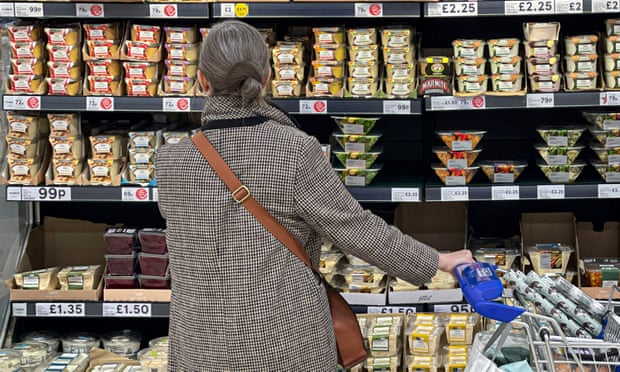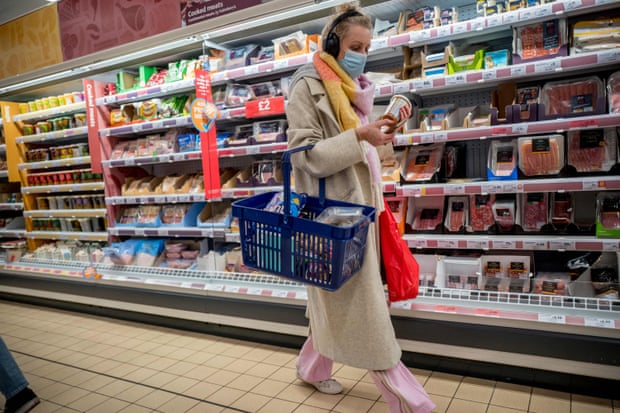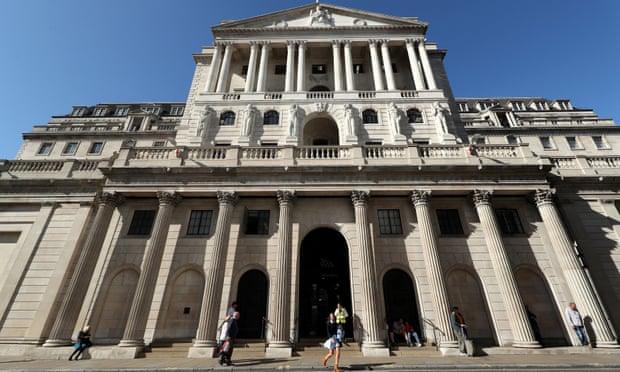Cost of living crisis worsens, piling pressure on Bank of England to raise interest rates again
Britain’s cost of living crisis worsened in December after inflation jumped to 5.4% – its highest level in almost 30 years – driven by the higher cost of clothes, food and footwear.
Heaping further pressure on Bank of England policymakers to raise interest rates when they meet next month, the price of furniture and eating out also increased as shortages of staff pushed up wage costs and hold-ups at UK ports hiked the cost of imports.
The Bank expects the consumer prices index (CPI) to rise to 6% by April, while some analysts have forecast it could hit 7% unless the government decides to pump billions of pounds into the energy sector to cap spiralling heating costs.
Ofgem, the energy regulator, must announce a rise in the price cap on energy bills in the next fortnight and it is understood ministers are scrambling to put together a package of measures to prevent an estimated annual increase of £500 per household.
Speaking to MPs in parliament, the Bank’s governor, Andrew Bailey, said financial markets now expected energy prices to remain high until mid-2023. This follows forecasts only a few months ago of a decline this summer.
Bailey said energy prices had been a significant inflationary pressure last year and were responsible for about 1.5 percentage points of November’s 5.1% inflation rate.
Oil prices have made a large contribution to the increasing cost of living, a trend that has continued this year after Brent crude rose by 15% rise this month to more than $80 a barrel. Analysts at Goldman Sachs think it will hit $100 a barrel later this year.
Figures for wages in November showed pay packets increased by 4.2%, including bonuses, on the previous year, but fell behind the rising cost of living by 0.9%. Unless there was a leap in wages in December, the increase in prices will leave the average worker even worse off.
The only positive sign for the chancellor, Rishi Sunak, who has come under intense pressure to provide funds for low income families to cope with rising costs, was that the Office for National Statistics reported a downward trend in the monthly rise in CPI. It increased by 0.5% in December, down from 0.7% in November and 1.1% in October.
The cost of goods rose by 6.9% while services increased by only 3.1%, giving hope that once global shortages of goods begin to ease, the inflation rate could fall steeply back towards the Bank’s 2% target.
Kitty Ussher, the chief economist at the Institute of Directors, said she was concerned that the increase from 5.1% in November came mainly from higher food prices.
“Not only does this provide additional evidence that inflation is becoming endemic rather than transitory, it also bodes ill for households facing multiple rises in the cost of living this spring. We therefore expect interest rates to rise again when the Bank of England monetary policy committee next meets in early February.”
UK inflation rises to highest level in almost 30 years at 5.4%
UK inflation rises to highest level in almost 30 years at 5.4%
-

dutchman - Site Admin
- Posts: 57138
- Joined: Fri Oct 23, 2009 12:24 am
- Location: Spon End
Re: UK inflation rises to highest level in almost 30 years at 5.4%
the inflation rate could fall steeply back towards the Bank’s 2% target
Yes, and pigs could fly!
-

dutchman - Site Admin
- Posts: 57138
- Joined: Fri Oct 23, 2009 12:24 am
- Location: Spon End
Re: UK inflation rises to highest level in almost 30 years at 5.4%
The problem is that interest rates have been artificially held back and suppressed to suit political agendas. This was always an unsustainable situation and now people are going to get burned.
Of course it'll fit; you just need a bigger hammer.
-

rebbonk - Posts: 71977
- Joined: Thu Nov 12, 2009 6:01 am
Re: UK inflation rises to highest level in almost 30 years at 5.4%
According to data collated by the research firm Assosia, the price of a basket of 18 staples has risen by 8.3 per cent which is EXACTLY the amount that pensions would have risen by under the triple lock! 
-

dutchman - Site Admin
- Posts: 57138
- Joined: Fri Oct 23, 2009 12:24 am
- Location: Spon End
Re: UK inflation rises to highest level in almost 30 years at 5.4%
UK inflation forecast to hit 8% in April amid cost of living crisis
Britain’s hard-pressed households have been warned to expect a fresh squeeze on their living standards in the coming months after the annual inflation rate climbed for a 13th month to its highest point in almost 30 years.
Economists said they expected the government’s preferred measure of the yearly jump in the cost of living – the consumer prices index – to rise from 5.5% in January to almost 8% in April when household energy bills will soar by hundreds of pounds.
The latest figures from the Office for National Statistics (ONS) showed that the least generous January clothing and footwear sales since 1990 were responsible for the 0.1 percentage point increase in the annual inflation rate last month. Prices actually fell on the month but by a smaller amount than in January 2021.
Rishi Sunak said the government understood the pressures people were facing with the cost of living, but the chancellor was warned by a leading thinktank that rising inflation meant it would cost the Treasury an extra £11bn this year to service the UK’s national debt of more than £2tn.
Isabel Stockton, a research economist at the Institute for Fiscal Studies, said interest payments on index-linked debt were calculated using an alternative measure of inflation – the retail prices index – which is running at 7.8%, considerably higher than anticipated in last October’s budget.
“As a result we now project that central government spending on debt interest this financial year will come in at around £69bn, some £11bn higher than the £58bn forecast in the October 2021 budget and £27bn above the £42bn forecast in the March 2021 budget,” Stockton said.
City economists had expected CPI inflation to remain at 5.4% in January and said the latest increase elevated the chances of the Bank of England raising interest rates for a third successive time when its monetary policy committee meets next month.
-

dutchman - Site Admin
- Posts: 57138
- Joined: Fri Oct 23, 2009 12:24 am
- Location: Spon End
Re: UK inflation rises to highest level in almost 30 years at 5.4%
interest payments on index-linked debt were calculated using an alternative measure of inflation – the retail prices index – which is running at 7.8%
That used to be the figure on which benefit rises were calculated!
The rising costs of some household goods also pushed up inflation but were offset partly by cheaper petrol and diesel prices in January after record highs at the end of 2021.
Not where I live they weren't, petrol and diesel prices were even higher!
-

dutchman - Site Admin
- Posts: 57138
- Joined: Fri Oct 23, 2009 12:24 am
- Location: Spon End
Re: UK inflation rises to highest level in almost 30 years at 5.4%
Men’s suit removed from UK ‘inflation basket’
The traditional men’s suit has been removed from the basket of goods used to calculate the annual inflation rate – the latest casualty of the increase in working from home since the start of the Covid pandemic two years ago.
The Office for National Statistics said the change in working patterns meant the suit – ever-present in the basket since its inception in 1947 – was no longer one of the more than 700 representative goods and services selected to measure the UK’s cost of living.
Announcing details of this year’s changes, the ONS said a new men’s formal jacket or blazer item was being introduced to ensure men’s formal and business wear was still represented in the selection.
Other items that will no longer be tracked include doughnuts, which are being replaced by multipacks of cakes, and coal, which has been removed in anticipation of the government ban on domestic sales of the fuel from next year.
Other items added to the basket for the first time this year also reflected lifestyle changes since the start of the pandemic. These included antibacterial surface wipes, sports bras/crop tops and collars for dogs and cats.
The ONS said demand for antibacterial products was still high, and people had responded to the pandemic by exercising more and owning more pets.
Canned beans, chickpeas and lentils entered the basket for the first time alongside meat-free sausages, reflecting the growth in vegetarianism and veganism, driven by greater consciousness of health, animal welfare and environmental concerns.
Last year, hand sanitiser, smartwatches and hand weights for home exercise were added. The ONS said this year it had added 19 items, removed 15 and left 715 unchanged.
The UK’s statistical agency also announced it would be using “new and improved” data sources as part of an attempt to provide a clearer picture of what was happening to prices.
It said it was working with retailers to get data straight from their tills, which would include how much each item costs and how many of each type – including value and premium brands – were available from shops in every part of the UK.
Beckett said: “Today’s announcement is a key part of our long-term transformation of prices collection that is designed to keep the measurement of UK inflation as accurate and relevant as possible.”
-

dutchman - Site Admin
- Posts: 57138
- Joined: Fri Oct 23, 2009 12:24 am
- Location: Spon End
Re: UK inflation rises to highest level in almost 30 years at 5.4%
Who do they think they're kidding?
The sole reason for the changes is to make the official measure of inflation lower than it really is.
There has never been a revision of the inflation rate upwards, it has always been downwards. Go figure?
If UK inflation was to be calculated by the same method as in the 1980s it would now be running at between 16% and 20%.
The sole reason for the changes is to make the official measure of inflation lower than it really is.
There has never been a revision of the inflation rate upwards, it has always been downwards. Go figure?
If UK inflation was to be calculated by the same method as in the 1980s it would now be running at between 16% and 20%.
-

dutchman - Site Admin
- Posts: 57138
- Joined: Fri Oct 23, 2009 12:24 am
- Location: Spon End
Re: UK inflation rises to highest level in almost 30 years at 5.4%
Bank of England raises interest rates to 0.75% as inflation soars
The Bank of England has responded to the likelihood that the war in Ukraine will push inflation to around 10% this year by raising interest rates back to the pre-pandemic level of 0.75%.
Threadneedle Street’s monetary policy committee (MPC) voted 8-1 to increase borrowing costs by 0.25 percentage points – the first time the Bank has raised rates at three successive meetings in more than two decades.
Bank of England warns inflation could breach 8%, raises rates, condemns Russia’s invasion of Ukraine – business live
Read more
The Bank said Russia’s invasion had forced it to rethink its forecast for the peak of inflation this year and it was now expected to be “several percentage points” higher than the 7.25% it had previously forecast.
There had been speculation before the meeting that some MPC members might opt for a half-point increase, but only one – Jon Cunliffe – dissented from the majority by voting to keep interest rates on hold.
The other eight MPC members decided fresh action was needed to return inflation – currently at a three-decade high of 5.5% – to the government’s 2% target. They stressed the tightness of the labour market and upward pressures on costs and prices.
Despite strong inflationary pressure, the Bank adopted a less aggressive tone about future rate increases than the US Federal Reserve, which is pencilling in a further six increases in borrowing costs this year. The MPC said a further “modest” tightening of policy could be needed over the coming months, depending on the medium-term outlook for inflation.
The Bank thinks the annual inflation rate will rise to around 8% in the second quarter of 2022, and perhaps even higher later this year.
-

dutchman - Site Admin
- Posts: 57138
- Joined: Fri Oct 23, 2009 12:24 am
- Location: Spon End
Re: UK inflation rises to highest level in almost 30 years at 5.4%
The Bank thinks the annual inflation rate will rise to around 8% in the second quarter of 2022, and perhaps even higher later this year.
Which is the exact opposite of everything they've said up till now!
-

dutchman - Site Admin
- Posts: 57138
- Joined: Fri Oct 23, 2009 12:24 am
- Location: Spon End
Who is online
Users browsing this forum: No registered users and 10 guests
-
- Ads





